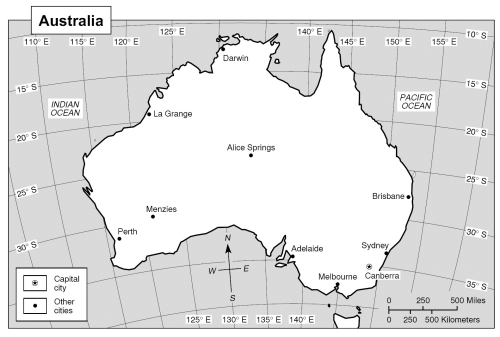Scales, Maps and Ratios
Scales
A scale compares the distance on a map to the actual distance on the ground. Scales can be depicted in a few different ways:
Graphic scale
A graphic scale represents a scale by using a small line with markings similar to a ruler. One side of the line represents the distance on the map, while the other side represents the true distances of objects in real life. By measuring the distance between two points on a map and then referring to the graphic scale, we can calculate the actual distance between those points.

In this picture, you can see that one centimetre on the scale represents $250$250 kilometres in real life.
Verbal scale
A verbal scale uses words to describe the ratio between the map's scale and the real world. For example, we could say "One centimetre equals fifteen kilometres" or we could write it as $1$1cm = $15$15km. This means that one centimetre on the map is equivalent to $15$15 kilometres in the real world.
Scale Ratio
Some maps use a representative fraction to describe the ratio between the map and the real world. If you need a refresher about ratios, see Looking at Relationships between Different Groups. We write scale ratios for maps just like other ratios with the colon in the middle. For example $1:100000$1:100000.
Examples
Question 1
Convert the following description to a proper scale ratio: $5$5 cm on the map = $25$25 m in real life.
Remember we need to have our two quantities in the same unit of measurement in a ratio. I'm going to convert everything to centimetres.
| $25$25 m | $=$= | $25\times100$25×100 cm |
| $=$= | $2500$2500 cm |
Once we have equivalent quantities, we can write it as a scale ratio.
| $5:2500$5:2500 | $=$= | $1:500$1:500 |
Question 2
Question: Given that the scale on a map is $1$1:$50000$50000, find the actual distance between two points that are $8$8 cm apart on the map.
Think: This means that $1$1 cm on the map represents $50000$50000cm (or $500$500 m) in real life.
Do: So to work out how far $8$8 cm represents, we need to multiply $8$8 by $50000$50000. Then convert to km.
| $8\times50000$8×50000 | $=$= | $400000$400000 cm |
| $=$= | $4000$4000 m | |
| $=$= | $4$4 km |
Now let's look at how we can do this process in reverse.
Question 3
Question: Given that the scale of a map of a garden is $1$1:$2000$2000 , how far apart should two fountains be drawn on the map if the actual distance between the fountains is $100$100 m? Express your answer in centimetres.
Question 4
a) Given that the scale of a map is $1$1:$1000$1000, find the actual distance (in centimetres) between two points that are drawn $14$14 cm apart on a map.
Think: We are making our ratio $14$14 times bigger (to make sure we keep it proportional)
Do: $1$1:$1000$1000 = $14$14:$14000$14000
The actual distance between to points is $14000$14000 cm.
b) Convert your answer to metres.
Think: There are $100$100 centimetres in $1$1 metre, so I am going to divide my answer in (a) by $100$100.
Do: $14000\div100=140$14000÷100=140 metres
Further Examples
Question 5
The scale on a map of a garden is $1:2000$1:2000. How far apart on the map should two fountains be drawn if the actual distance between the fountains is $100$100 metres? Express your answer in centimetres.
Question 6
The scale on a map is $1:400000$1:400000. How far apart on the map should two train stations be drawn if the actual distance between the stations is $100$100 km? Express your answer in centimetres.